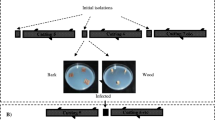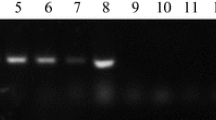Abstract
Two commercial nurseries located in Comunidad Valenciana region (central-eastern Spain) were sampled in 2010 to evaluate whether the grapevine nursery propagation process could be a source of black-foot disease pathogens. Samples were taken from four sources of the propagation process: pre-grafting hydration tanks, scissors used for cutting buds, omega-cut grafting machines, and peat used for callusing. DNA from these samples was extracted and multiplex nested-PCR using primers specific for “Cylindrocarpon” pauciseptatum, Ilyonectria liriodendri and I. macrodidyma-complex (composed of I. alcacerensis, I. estremocensis, I. macrodidyma, I. novozelandica, I. torresensis, and two undescribed species) was used to identify the species present. Ilyonectria liriodendri and I. macrodidyma-complex were detected in hydration tanks, scissors, grafting machines and peat, I. macrodidyma-complex being the most frequent. Additionally, ten grafted cuttings each from five grapevine scion/rootstock combinations were collected from each nursery immediately after callusing, and again after one growing season in a nursery field. Roots of these grafted cuttings and plants were sampled to isolate the fungal pathogens. Only I. torresensis was isolated after callusing, while I. liriodendri, I. novozelandica and I. torresensis were isolated after one growing season, showing the highest incidence at this latter sampling time. Moreover, DNA was extracted from roots and analyzed as described before. Ilyonectria liriodendri and I. macrodidyma-complex were also detected at both sampling times. The use of the multiplex nested-PCR technique improved the detection of I. liriodendri and I. macrodidyma-complex from grafted cuttings and plants in both nurseries. This work shows that the grapevine nursery propagation process should be considered as a potential infection source for black-foot disease pathogens, and confirms that infections caused by Ilyonectria spp. in grapevine planting material increase markedly after one growing season in nursery fields.

Similar content being viewed by others
References
Agustí-Brisach, C., Gramaje, D., León, M., García-Jiménez, J., & Armengol, J. (2011). Evaluation of vineyard weeds as potential hosts of black-foot and Petri disease pathogens. Plant Disease, 95, 803–810.
Agustí-Brisach, C., Gramaje, D., García-Jiménez, J., & Armengol, J. (2013). Detection of black-foot and Petri disease pathogens in natural soils of grapevine nurseries and vineyards using bait plants. Plant and Soil, 364, 5–13.
Alaniz, S., Leon, M., García-Jiménez, J., Abad, P., & Armengol, J. (2007). Characterization of Cylindrocarpon species associated with black-foot disease of grapevine in Spain. Plant Disease, 91, 1187–1193.
Alaniz, S., Armengol, J., García-Jiménez, J., Abad-Campos, P., & León, M. (2009). A multiplex PCR system for the specific detection of Cylindrocarpon liriodendri, C. macrodidymum, and C. pauciseptatum from grapevine. Plant Disease, 93, 821–825.
Alaniz, S., Abad-Campos, P., García-Jiménez, J., & Armengol, J. (2011). Evaluation of fungicides to control Cylindrocarpon liriodendri and Cylindrocarpon macrodidymum in vitro, and their effect during the rooting phase in the grapevine propagation process. Crop Protection, 30, 489–494.
Aroca, A., & Raposo, R. (2007). PCR-based strategy to detect and identify species of Phaeoacremonium causing grapevine diseases. Applied and Environmental Microbiology, 73, 2911–2918.
Aroca, A., García-Figueres, F., Bracamonte, L., Luque, J., & Raposo, R. (2006). A survey of trunk pathogens within rootstocks of grapevines in Spain. European Journal of Plant Pathology, 115, 195–202.
Aroca, A., Gramaje, D., Armengol, J., García-Jiménez, J., & Raposo, R. (2010). Evaluation of the grapevine nursery propagation process as a source of Phaeoacremonium spp. and Phaeomoniella chlamydospora and occurrence of trunk disease pathogens in rootstock mother vines in Spain. European Journal of Plant Pathology, 126, 165–174.
Billones-Baaijens, R., Ridgway, H. J., Jones, E. E., Cruickshank, R. H., & Jaspers, M. V. (2013a). Prevalence and distribution of Botryosphaeriaceae species in New Zealand grapevine nurseries. European Journal of Plant Pathology, 135, 175–185.
Billones-Baaijens, R., Ridgway, H. J., Jones, E. E., & Jaspers, M. V. (2013b). Inoculum sources of Botryosphaeriaceae species in New Zealand grapevine nurseries. European Journal of Plant Pathology, 135, 159–174.
Bleach, C. M., Cope, R. J., Jones, E. E., Ridgway, H. J., & Jaspers, M. V. (2008). Impact of mycorrhizal colonisation on grapevine establishment in Cylindrocarpon infested soil. New Zealand Plant Protection, 61, 311–316.
Bleach, C. M., Jones, E. E., & Jaspers, M. V. (2009). Biofumigation with Brassica spp. for the control of Cylindrocarpon black foot disease of grapevines. New Zealand Plant Protection, 62, 396.
Brayford, D. (1993). Cylindrocarpon. In L. L. Singleton, J. D. Mihail, & C. M. Rush (Eds.), Methods for research on soilborne phytopathogenic fungi. St. Paul: APS Press. 265 pp.
Cabral, A., Groenewald, J. Z., Rego, C., Oliveira, H., & Crous, P. W. (2012a). Cylindrocarpon root rot: multi-gene analysis reveals novel species within the Ilyonectria radicicola species -complex. Mycologycal Progress, 11, 655–688.
Cabral, A., Rego, C., Nascimento, T., Oliveira, H., Groenewald, J. Z., & Crous, P. W. (2012b). Multi-gene analysis and morphology reveal novel Ilyonectria species associated with black foot disease of grapevines. Fungal Biology, 116, 62–80.
Cardoso, M., Diniz, I., Cabral, A., Rego, C., & Oliveira, H. (2012). Unveiling inoculum sources of Black foot pathogens in a commercial grapevine nursery. Phytopatologia Mediterranea, 51, 442–443.
Chaverri, P., Salgado, C., Hirooka, Y., Rossman, A. Y., & Samuels, G. J. (2011). Delimitation of Neonectria and Cylindrocarpon (Nectriaceae, Hypocreales, Ascomycota) and related genera with Cylindrocarpon-like anamorphs. Studies in Mycology, 68, 57–78.
Crous, P. W., Groenewald, J. Z., Risede, J. M., & Hywel-Jones, N. L. (2004). Calonectria species and their Cylindrocladium anamorphs: species with sphaeropedunculate vesicles. Studies in Mycology, 50, 415–429.
Dhingra, O. D., & Sinclair, J. B. (1995). Basic plant pathology methods (2nd ed.). Boca Raton: CRC Press. 434 p.
Dubrovski, S., & Fabritius, A. L. (2007). Occurrence of Cylindrocarpon spp. in nursery grapevines in California. Phytopathologia Mediterranea, 46, 84–86.
Edwards, J., Pascoe, I. G., Salib, S., & Laukart, N. (2003). Phaeomoniella chlamydospora and Phaeoacremonium aleophilum can spread into grapevine canes from trunks of infected mother vines. Page 29 in: Proc. 3rd Int. Workshop Grapevine Trunk Dis., Lincoln University, Canterbury, New Zealand.
Feliciano, A. J., & Gubler, W. D. (2001). Histological investigations on infection of grape roots and shoots by Phaeoacremonium spp. Phytopathologia Mediterranea, 40S, 387–393.
Fourie, P. H., & Halleen, F. (2004). Occurrence of grapevine trunk disease pathogens in rootstock mother plants in South Africa. Australasian Plant Pathology, 33, 313–315.
Fourie, P. H., & Halleen, F. (2006). Chemical and biological protection of grapevine propagation material from trunk disease pathogens. European Journal of Plant Pathology, 116, 255–265.
Gardes, M., & Bruns, T. D. (1993). ITS primers with enhanced specificity for basiodiomycetes-applications to the identification of mycorrhizae and rusts. Molecular Ecology, 2, 113–118.
Giménez-Jaime, A., Aroca, A., Raposo, R., García-Jiménez, J., & Armengol, J. (2006). Occurrence of fungal pathogens associated with grapevine nurseries and the decline of young vines in Spain. Journal of Phytopathology, 154, 598–602.
Gramaje, D., & Armengol, J. (2011). Fungal trunk pathogens in the grapevine propagation process: potential inoculum sources, detection, identification, and management strategies. Plant Disease, 95, 1040–1055.
Gramaje, D., Muñoz, R. M., Lerma, M. L., García-Jiménez, J., & Armengol, J. (2009). Fungal grapevine trunk pathogens associated with Syrah decline in Spain. Phytopathologia Mediterranea, 48, 396–402.
Gramaje, D., Alaniz, S., Abad-Campos, P., García-Jiménez, J., & Armengol, J. (2010). Effect of hot-water treatments in vitro on conidial germination and mycelial growth of grapevine trunk pathogens. Annals of Applied Biology, 156, 231–241.
Gramaje, D., Mostert, L., & Armengol, J. (2011). Characterization of Cadophora luteo-olivacea and C. melinii isolates obtained from grapevines and environmental samples from grapevine nurseries in Spain. Phytopathologia Mediterranea, 50, S112–S126.
Green, M. R., & Sambrook, J. (2012). Molecular cloning. New edition. A laboratory manual. Long Island: Cold Spring Harbor Laboratory Press. 2028 p.
Halleen, F., Crous, P. W., & Petrini, O. (2003). Fungi associated with healthy grapevine cuttings in nurseries, with special reference to pathogens involved in the decline of young vines. Australasian Plant Pathology, 32, 47–52.
Halleen, F., Schroers, H. J., Groenewald, J. Z., & Crous, P. W. (2004). Novels species of Cylindrocarpon (Neonectria) and Campylocarpon gen. nov. associated with black-foot disease of grapevines (Vitis spp). Studies in Mycology, 50, 431–455.
Halleen, F., Fourie, P. H., & Crous, P. W. (2006). A review of black-foot disease of grapevine. Phytopathologia Mediterranea, 45, S55–S67.
Halleen, F., Fourie, P. H., & Crous, P. W. (2007). Control of black foot disease in grapevine nurseries. Plant Pathology, 56, 637–645.
Mostert, L., Halleen, F., Fourie, P., & Crous, P. W. (2006). A review of Phaeoacremonium species involved in Petri disease and esca of grapevines. Phytopathologia Mediterranea, 45, S12–S29.
Oliveira, H., Rego, C., & Nascimento, T. (2004). Decline of Young grapevines caused by fungi. Acta Horticulturae, 652, 295–304.
Pascoe, I. G., & Cottral, E. H. (2000). Developments in grapevine trunk diseases research in Australia. Phytopathologia Mediterranea, 39, 68–75.
Petit, E., & Gubler, W. D. (2006). Influence of Glomus intraradices on black foot disease caused by Cylindrocarpon macrodidymum on Vitis rupestris under controlled conditions. Plant Disease, 90, 1481–1484.
Rego, C., Farropas, L., Nascimento, T., Cabral, A., & Oliveira, H. (2006). Black foot of grapevine: sensitivity of Cylindrocarpon destructans to fungicides. Phytopathologia Mediterranea, 45, S93–S100.
Retief, E., McLeod, A., & Fourie, P. H. (2006). Potential inoculum sources of Phaeomoniella chlamydospora in South African grapevine nurseries. European Journal of Plant Pathology, 115, 331–339.
Rumbos, I., & Rumbou, R. (2001). Fungi associated with esca and young grapevine decline in Greece. Phytopathologia Mediterranea, 40, S330–S335.
Schroers, H. J., Zerjav, M., Munda, A., Halleen, F., & Crous, P. W. (2008). Cylindrocarpon pauciseptatum sp. nov., with notes on Cylindrocarpon species with wide, predominantly 3-septate macroconidia. Mycological Research, 112, 82–92.
Serra, S., Mannoni, M. A., Ligios, V., & Fiori, P. P. (2011). Occurrence of Phaeomoniella chlamydospora on grapevine planting material in Sardinia and its control with combined hot water and cyproconazole treatments. Phytopathologia Mediterranea, 50, S61–S76.
Spagnolo, A., Marchi, G., Peduto, F., Phillips, A. J. L., & Surico, G. (2011). Detection of Botryosphaeriaceae species within grapevine woody tissues by nested PCR, with particular emphasis on the Neofusicocum parvum/N. ribis complex. European Journal of Plant Pathology, 129, 485–500.
Waite, H., & May, P. (2005). The effects of hot water treatment, hydration and order of nursery operations on cuttings of Vitis vinifera cultivars. Phytopathologia Mediterranea, 44, 144–152.
Whiteman, S. A., Jaspers, M. V., Stewart, A., & Ridgway, H. J. (2003). Identification of potential sources of Phaeomoniella chlamydospora in the grapevine propagation process. Page 26 in: Proc. Int. Workshop Grapevine Trunk Dis. 3rd. Lincoln, New Zealand.
Acknowledgments
This research was financially supported by the Project RTA2010-00009-C03-03 (Instituto Nacional de Investigación y Tecnología Agraria y Alimentaria INIA, Spain) and the European Regional Development Fund (ERDF), and performed within the Programme VLC/Campus, Microcluster IViSoCa (Innovation for a Sustainable Viticulture and Quality). We acknowledge V. Garrigues for technical assistance.
Author information
Authors and Affiliations
Corresponding author
Rights and permissions
About this article
Cite this article
Agustí-Brisach, C., Gramaje, D., García-Jiménez, J. et al. Detection of black-foot disease pathogens in the grapevine nursery propagation process in Spain. Eur J Plant Pathol 137, 103–112 (2013). https://doi.org/10.1007/s10658-013-0221-8
Accepted:
Published:
Issue Date:
DOI: https://doi.org/10.1007/s10658-013-0221-8




